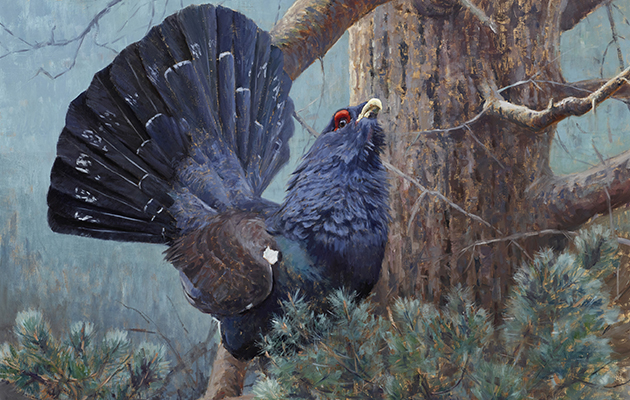Few of us will ever get to see a capercaillie lekking live. However, thanks to Justin Prigmore we can still appreciate the spectacle. By Janet Menzies
It was his love of wildlife that led Justin Prigmore to painting. Close and careful study is what allows him to capture his subjects with such precision, as he explains to Janet Menzies.
For more sporting artists, Tanja Möderscheim was inspired by her country’s heritage tulips and the Dutch Masters to forge a career as an artist. And Nick Orr remarkably captures a whole sporting day on a single feather.
JUSTIN PRIGMORE
If you are ever lucky enough to have a close encounter with a capercaillie, perhaps early one morning on your way home from a dawn roe stalk, the experience can be quite alarming. There is an initial impression of a big, shiny, black thing and a general feeling of what the hell is that? But the chances are that you haven’t experienced a capercaillie in the wild, as there are now only about 1,000 of them clinging on in Speyside. So it’s just as well that Justin Prigmore is passionate about painting and conserving Scotland’s heather-based answer to the condor.

Full Tilt.
“I love capturing the size of them and their feistiness,” enthuses Prigmore. “I have probably spent more time professionally with capercaillie and their conservation than anything. I did my Master’s degree in ecology and worked for the Cairngorms National Park on capercaillie conservation. I was monitoring their lek sites, which means you have to sleep out the night before so you can watch the lekking start up.” Watching the capercaillie fan his tail like a turkey and throw his handsome head in the air from a heathery mound in a Caledonian pine forest is one of the last great British wildlife experiences.
Prigmore says, “I am a painter because of loving wildlife. I needed to be able to portray these amazing things I was seeing. It is so important we don’t lose the capercaillie again. In the 1970s, there were about 20,000 capercaillie in Scotland but we have seen a 90% decline in population. Their range has contracted so much. These forests round Carrbridge and Grantown-on-Spey are the last places where they are hanging on. Dogs, people and tourism create a big problem for the birds, and we have to manage this. I am involved in a project in Carrbridge where we are creating places for people to walk their dogs and we are managing the forest.”
HOME IN THE HIGHLANDS
Originally from Wales, Prigmore’s love of wildlife has led him to the world’s great wilderness areas, from the Rockies to Africa and, eventually, the Highlands. “It has been a long journey to end up here but my wife and I have just built my dream studio outside Grantown-on-Spey, with a view of the Cairngorms. I am excited now because I have never had a really big studio where you can stand back to view a large painting. So one of the first paintings I did was an 80in grouse painting, with the birds flying towards you. Now I want to create some monumental pieces. I want it to be that you can almost walk into them – to get that feeling of being there. The detail interests me much less than conveying the energy, which you can do when you work on a big scale. I find people respond to that. Clients want those big brush strokes and the artist to be attacking the canvas and capturing the action of the wildlife they know and love.”

Justin Prigmore in his new, larger studio.
Many of Prigmore’s clients are leading Highland landowners who invite him to paint on their estates. “I had a grandfather who worked in the pits and my dad worked in the steel works, so I can’t say it is hard work to go out stalking. But it is about spending time and researching the subject, and the landowning and sporting community has really impressed me. Working with them I get to understand what they love about a piece of ground they own. I observe and see what happens. I can spend a week doing research and preparation before starting a painting, and that might include something like putting up a hide so that I can watch black grouse.”
Having worked with both the Cairngorm National Park Authority and the owners of the Cairngorms great estates, Prigmore is well aware of the controversy surrounding conservation and landownership in the Highlands. “Scotland gets a bad rap for absentee landowners but these people want to make their land better. When I am there as an artist, I get the opportunity to talk to them about conservation and their legacy, and what comes across is how much they love the Highlands; they pour so much money into their estates. They are passionate about the land and, as highly successful people elsewhere in life, they are smart enough to come up with solutions.”

Haring Around.
Prigmore’s personal solution is to study, understand and, above all, paint these fragile environments, not just in Scotland but all over the world.
Justin Prigmore exhibits at several major game fairs and House of Bruar, Blair Athol, Scotland. He is a trustee of Scotland, The Big Picture (scotlandbigpicture.com). You can also view his work at: prigmoreart.com





